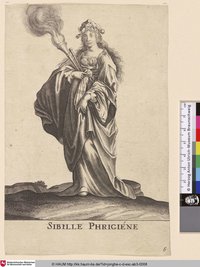
"Die Phrygische Sibylle ist eine der nach Varro, einem römischen Schriftsteller des 1. Jahrhunderts v. Chr., von Laktanz unterschiedenen zehn Sibyllen, die jeweils mit einem geographischen Epithet versehen sind.
Weitere Quellen der griechischen und römischen Antike enthalten keine Hinweise auf eine Sibylle besonders aus damals als Teil Phrygiens verstandenen kleinasiatischen Regionen. Eventuell ist die Benennung einer Sibylle als „phrygisch“ allgemein als Anerkennung der langen Tradition der Ehrung eines weiblichen Sehertums dieser Regionen zu verstehen, zumal Phrygien als Ursprung des Kultes der Erdmutter und Großen Mutter Kybele bekannt war." - (Wikipedia (de) 14.11.2020)
![[Sibyllae Quatuor]](/data/nds/resources/images/202009/200w_000001-5f58715fb42c3.jpg)



